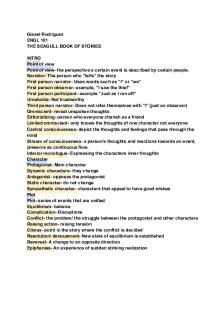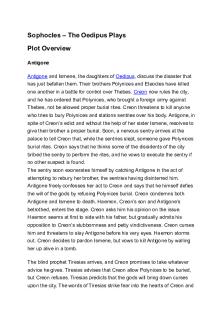THE Seagull BOOK OF Plays PDF

| Title | THE Seagull BOOK OF Plays |
|---|---|
| Author | Gissel Rodriguez |
| Course | Understanding Literature |
| Institution | University of Illinois at Chicago |
| Pages | 3 |
| File Size | 69.2 KB |
| File Type | |
| Total Downloads | 61 |
| Total Views | 174 |
Summary
These are notes and vocabulary regarding the series of books "THE Seagull BOOK OF Plays"...
Description
Gissel Rodriguez ENGL 101 THE SEAGULL BOOK OF PLAYS What is drama? Dramatic conventions- Devices, phrases, or actions that have, over time, become common than their meaning is immediately apparent. Chorus- A group of singers and dancers who participate in or comment on the action - Contemporary dramas don't use chorises (unless they are self-consciously, perhaps ironically, borrowing the ancient device). Cultural context- A play is written not primarily for reading, but instead as the guiding text for performing a story onstage. - A portformance helps you see that the very act of putting a play into action involves interpretation and analysis on the part of the director, the actors and every other artist that is involved in the production. The Parts of a Play Analysis- breaking down into parts Plot- the sequence of events that happen in a play 1. Equilibrium 2. Conflict 3. Rising action 4. Climax 5. Falling action 6. Resolution In media res- “In the mindset of things” Exposition- Background information in the opening scene to give viewers an understanding of the early stages of the plot. - The rising action depicts the escalating struggle of the conflict. Character- Is a person on the stage, a personage being acted for the audience. Genre- Westerns, crime films, horror, superhero movies etc Sympathetic characters- to wish them well and feel sorry for them when they suffer. Unsympathetic characters- not meant to sympathize Identify- to imagine yourself in the characters place Diction- The costumes, the actors boyd language, the way the character talks Protagonist- The character that the play focuses on Antagonist- The character the protagonist struggles against Dynamic character- any character who changes through the course of the play Static character- a character who does not change Stock character- Character may be so two-dimensional, even one-dimensional
Gissel Rodriguez ENGL 101 THE SEAGULL BOOK OF PLAYS Spectacle- Aristotle's term for what the audience sees- the play as a physical reality. Atmosphere- your attitude and mood Symbol- a thing that represents something else Universal symbol- Having such broad applicability Conventional symbol- The symbol has a meaning that is agreed on by a particular group of people Literary symbol- a thing that represents something else only within a particular work of literature. - Tragedy always begins with the protagonist in a state of prosperity - The conflict in a tragedy usually occurs between the protagonist and some larger force Reversal- the heroes original prosperity turns into poverty. Recognition- The falling action of tragedy typically reveals that the protagonist has gained some self- understanding. Hubris- a tragic flaw Comedy- A play that makes people laugh a lot - Comedy is much more difficult to describe and define than tragedy - The cimedic plot is generally the reverse of the tragic plot: the protagonist begins in a state of relative poverty and ends in a state of prosperity. - While tragedies often end in death, romantic comedies usually end in betrothal or marriage, a symbol of human renewal and fecundity. Major Moments in the History of Theater Greek Theater- Invented drama. - Drama grew out of religious festivals devoted to the worship of Dionysus, the god of wine. - Spoken dialogue became possible after a man named Thespis, from whose name comes the word thespian, added an actor to these charcoal dances and songs. - Drama as the playing out of a story really began with Aeschylus Elizabethan Theater- The term refers to the first Queen Elizaneth of Englsand who ruled from 1558 to 1603. - Entertainers performed modest scenes from wagons at fairs or, sometimes, in the banquet halls of the rich. - Shakespeare's Globe teacher was built on the southside of the River Thames in 1599.
Gissel Rodriguez ENGL 101 THE SEAGULL BOOK OF PLAYS - The theater was shaped like a doughnut. - The Elizabethan performed plays only during the daytime. Nineteenth- century Middle- Class Theater - The nineteenth century theater also sharply divided audiences according to economic status. - In general, nineteenth century theater demanded a much higher degree of realism than had been present. The Provincetown Players - They set about writing and staging plays they were interested in seeing: theater that would examine and interpret the national character and present to audience intelligent plays regardless of commercial concerns. Contemporary American Theater - h Regional Theaters - Tend to customize their repertories to the needs and interests of their local populations, and they usually cut against the economic grain- bringing theater to groups excluded by the highbrow nature of most contemporary theater. - Because they are incommerical, regional theaters do not often produce theatrical spectaculars - Typically, their plays take place in single settings, so that only me set has to be built for each production....
Similar Free PDFs

THE Seagull BOOK OF Plays
- 3 Pages

THE Seagull BOOK OF Poems
- 4 Pages

THE Seagull BOOK OF Stories
- 7 Pages

The Book of Miracles
- 26 Pages

Summary of the book
- 151 Pages

Morality Plays, everyman + topic
- 3 Pages

SEAGULL ANSWER
- 10 Pages

02 - Ch3 of The book
- 25 Pages

The Book of Forbidden KNOWLEDGE
- 67 Pages
Popular Institutions
- Tinajero National High School - Annex
- Politeknik Caltex Riau
- Yokohama City University
- SGT University
- University of Al-Qadisiyah
- Divine Word College of Vigan
- Techniek College Rotterdam
- Universidade de Santiago
- Universiti Teknologi MARA Cawangan Johor Kampus Pasir Gudang
- Poltekkes Kemenkes Yogyakarta
- Baguio City National High School
- Colegio san marcos
- preparatoria uno
- Centro de Bachillerato Tecnológico Industrial y de Servicios No. 107
- Dalian Maritime University
- Quang Trung Secondary School
- Colegio Tecnológico en Informática
- Corporación Regional de Educación Superior
- Grupo CEDVA
- Dar Al Uloom University
- Centro de Estudios Preuniversitarios de la Universidad Nacional de Ingeniería
- 上智大学
- Aakash International School, Nuna Majara
- San Felipe Neri Catholic School
- Kang Chiao International School - New Taipei City
- Misamis Occidental National High School
- Institución Educativa Escuela Normal Juan Ladrilleros
- Kolehiyo ng Pantukan
- Batanes State College
- Instituto Continental
- Sekolah Menengah Kejuruan Kesehatan Kaltara (Tarakan)
- Colegio de La Inmaculada Concepcion - Cebu






